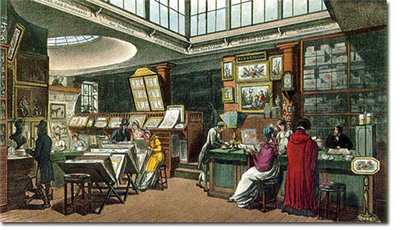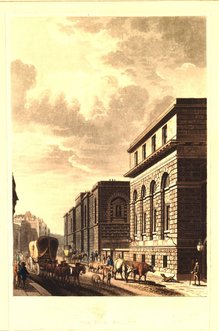On June 2, 1813, a trial was held at London’s central criminal court, The Old Bailey, where the book and print seller Rudolph Ackermann (1764-1834) accused a Soho print dealer named Peter Brown of “feloniously receiving one hundred and fifty-two books,” including five sets of the Abbey Church of St. Peter, Westminster and two sets of the Microcosm of London.
Brown was ultimately found not guilty because one of Ackermann’s artists, Thomas Sutherland (1785-1838), confessed to the crime of grand larceny. Sutherland was fined one shilling and released. For the original transcript, see the Old Bailey Online
When Sutherland was asked if he sold Brown copies of Ackermann’s books, he replied, “Yes, about five sets of Westminster Abbey; the first two sets at five pound each, and the others at four pound ten shillings. I swear positively to having sold from seven to ten sets; seven I am sure I have sold. The Microcosm was the same price, and about three sets at four pound ten shillings. I am sure I am speaking within compass of the number. I received money and goods both for them; the goods were furniture and birds. The agreement was to take part money and part goods.”
The artist continued… “[Brown] asked me … whether I was still in the service of Mr. Akerman [sic]. I told him I was, but that I should shortly quit it. He then said, Mr. Akerman [sic] has published some pretty works, and that he should like to possess them if he could get them cheap; he asked me if I could help him to any. I asked him what price he would go to. He desired me to name my own price. I named eight pound or eight guineas; I would get him a set of the Westminster Abbey; he ridiculed the idea. I told him the trade price was ten guineas, and the price to the public was fifteen guineas; he said, that would not do; he could get them cheaper; he did not mind what the trade gave. I took him one set, which I sold him for five pound.”
“…I could afford to let him have them a great deal cheaper than that, for in the way that he should dispose of them I need not fear any thing; he would take to any extent, and always pay ready money. On Thursday morning, the 15th of April, I saw Mr. [John] Simpson come out of his door, and when I came up Brown was at the door; he asked me if I knew that gentleman. I said I did, it was Mr. Simpson, a friend of Mr. Akerman’s [sic]. He then said he suspected all was not right, Mr. Simpson had been there the night before; his son had told him there were many copies in the house; he begged me to take away two sets, if I could deposit them safely. I took away two of the sets I had sold for four pound ten shillings.”
When Sutherland was asked if he deposited any pawnbrokers tickets with Brown, Sutherland replied, “Yes, I sold him some duplicates of sets I had pawned. Brown told me he expected to get into trouble, but he would not give up my name, nor was I to mention his.”
Henry Morland was called as a witness and said he knew Brown, “I exchanged with him for one set of the Westminster for a leaden figure that stood in my yard. I communicated it to Mr. Akerman [sic].” Then, John Simpson testified that Ackermann had asked him to go to Brown’s house and question him. Simpson goes on at length to describe Brown’s explanation, ending, “Not being able to make any thing more of him I went to Mr. Akerman [sic] and told him what he said.”
It is recorded that Brown’s lawyer call fifteen witnesses, who all gave him “a good character” and Brown was found not guilty. On the same day, Thomas Sutherland was indicted for feloniously stealing one hundred and fifty-two books that were the property of Rudolph Ackerman. “To this indictment the prisoner pleaded guilty, was fined 1 s. and discharged.”
Posted in honor of serving jury duty.


Do you have any further biographical material on this Thomas Sutherland, such as where he was born and who he married, and details of any children?
I ask because I am interested in identifyin a Thomas Sutherland who was associated with what I have been advised was the "Grenadier Light Co, 2nd battalion" in the period around 1800.